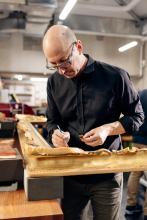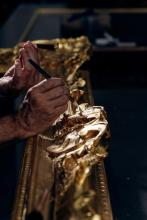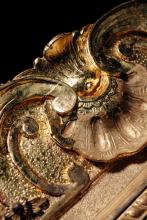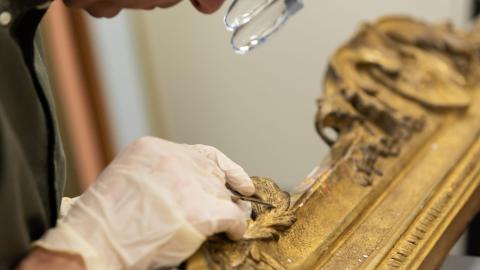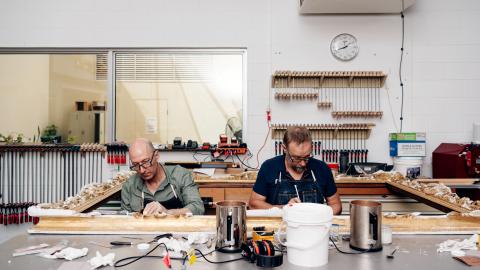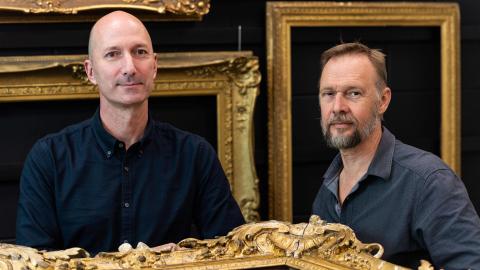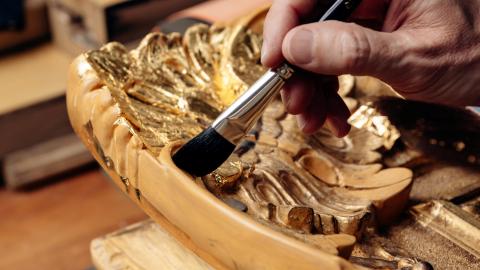Gilding: All that glitters
Restoring gold-gilded frames at QAGOMA
Gold leaf is 0.000125mm [0.125 microns] thick. You’d need 8000 leaves of gold leaf to make up a millimetre in thickness — so that’s the kind of surface that we’re dealing with.
— Robert Zilli, Conservation Framer
In more recent history, frames have often been finished in imitation gold leaf or paint to achieve the look of real gold — at least temporarily — but the frame that pairs with George Romney’s Mrs Yates as the Tragic Muse, Melpomene 1771 is the real deal, gilded by hand with gold leaf. In the 250 years since, the frame has been regularly regilded and touched up. To carry out conservation work that respects this frame’s long history, Robert and Damian’s goal is to gently clean the surface and ensure a visual consistency across the frame’s surface — its many strata of gold.


Careful cleaning of the Romney frame reveals bright gilding, QAG Framing Studio, July 2022 / Photograph: N Harth, QAGOMA
All that glitters
ROBERT ZILLI: The first thing is to identify what the finish is. Is it gilding and, if yes, what type: water gilding or oil gilding? Each will react differently to different cleaning methods. One of the frames hanging on the wall here in the studio is painted in what is commonly known as bronze paint, which will tarnish and eventually change colour to a brownish green, sometimes quite dark. [Other methods include glazing silver or tin leaf with a gold varnish.] Gold leaf, on the other hand, doesn’t tarnish. In a grand house full of fireplaces and smoking and who knows what else, all those pollutants settle on the surface and make the gold look dirty. But the gold itself isn’t tarnished at all. [The Romney frame] is a great example — though unfortunately it was once common practice, instead of cleaning the frame, to just regild over the original gold leaf.
DAMIAN BUCKLEY: Our analysis of cross-section samples taken from the frame has revealed that this frame has had four major regilding campaigns over the original gilded surface.


Macro photography of a cross-section of the Romney frame (left: under UV light; right: under visible light) reveals five total layers of gilding, QAG Framing Studio, January 2023 / Photographs: QAGOMA
RZ: What we’d view now as an historical object was once just part of the furniture in someone’s home. You’d repaint the walls, change the curtains and regild your frames. And gold can be sensitive, so they do get wear marks from cleaning. Because this frame has had five different layers of gilding on it [that is, the original plus four regildings], one of the issues is that some of the adhesion between layers is not great. It’s not a process of returning to the original first layer all over the frame; we’re looking for a stable platform to go forward from.
In the process of cleaning, we found large deposits — astonishing volumes — of eighteenth- or nineteenth-century dirt. You wonder, ‘Why is this layer not adhered to the layer below?’ Then you discover it is the dirt causing the problem. We have collected some [in a jar] and are considering what analysis we could have done — and what this might reveal.

Conservation work on the Romney frame reveals multiple layers of gilding and gold-look repairs, QAG Framing Studio, October 2022 / Photograph: C Callistemon, QAGOMA
RZ: Paul Curson, who used to work here before me, trained under Malcolm Green at the V&A [Victoria and Albert Museum, London]. Malcolm’s father was a gilder and his father was a gilder. Malcolm told Paul that frames such as this one would have been regilded every 40 to 50 years — that was the practice. Given these objects were just part of the furniture, there wasn’t a need to conserve the original finish when they could just have them re-gessoed and regilded. You’ve got a bright new gold frame and that’s what the owners expected. Unfortunately, all that gesso has obscured a lot of the ornament. In some areas, we’re able to get back to that original layer — revealing a bit more of the original ornament — and other areas we clean and leave as is.
DB: Some parts, like the flowers, have lost the crispness or been filled in, as Rob said. But that’s come back in a number of important architectural areas of the frame, so to our eye it’s certainly starting to read better, even though the finish might look a bit shabby — or inconsistent — at this stage of the treatment.

Conservation work on the Romney frame restores fine-carved details like flowers, QAG Framing Studio, October 2022 / Photograph: C Callistemon, QAGOMA
RZ: Another method that people used to ‘repair’ frames was to apply gold paints. So that also poses another challenge: to remove that paint and not damage the gold leaf underneath.
DB: It’s surprising how much sharpness and detail is obscured in the carving by subsequent layers of gesso and paint.
RZ: The first step is a gentle surface dusting to remove loose dirt and dust — being cautious as some of the gesso can be quite fragile, and it is important not to cause any further damage. We were fortunate enough to have funding from the QAGOMA Foundation to bring Malgorzata (Margaret) Sawicki — formerly the head of the Frames Conservation Department at the Art Gallery of New South Wales — to work with us for a week. Dr Sawicki is now retired and has time to mentor frame conservators.

Dr Malgorzata Sawicki (second from left) advises QAGOMA’s conservation framers; in the background, frames finished with alternatives to gilding (e.g. bronze paint) are hung on the wall, QAG Framing Studio, July 2022 / Photograph: N Harth, QAGOMA
RZ: In that week, we developed a treatment plan: we conducted tests on various areas of the frame to see what would work as a cleaning agent and what wouldn’t. And then from those solvents we were using, we developed gels — they kind of look like hand sanitiser — we could then apply selectively to areas of the frame to remove the surface dirt, but not affect the gold leaf. Just to give you an idea, gold leaf is 0.000125mm [0.125 microns] thick. (The gold leaf used on this frame is around 22–23 carat, as is the leaf we use here at the Gallery.) You’d need 8000 leaves to make up a millimetre in thickness, so that’s the kind of surface that we’re dealing with — and that’s how delicate and fragile that surface is. There’s a bit of chemistry involved!
QAGOMA Conservation Framers restore the Romney frame's glow with the application of new gold leaf, QAG Framing Studio, February 2024 / Photographs: J Ruckli

A QAGOMA Conservation Framer applies gold leaf to a section of frame with a special type of brush, called a gilder's tip, QAG Framing Studio, February 2024 / Photograph: C Callistemon
